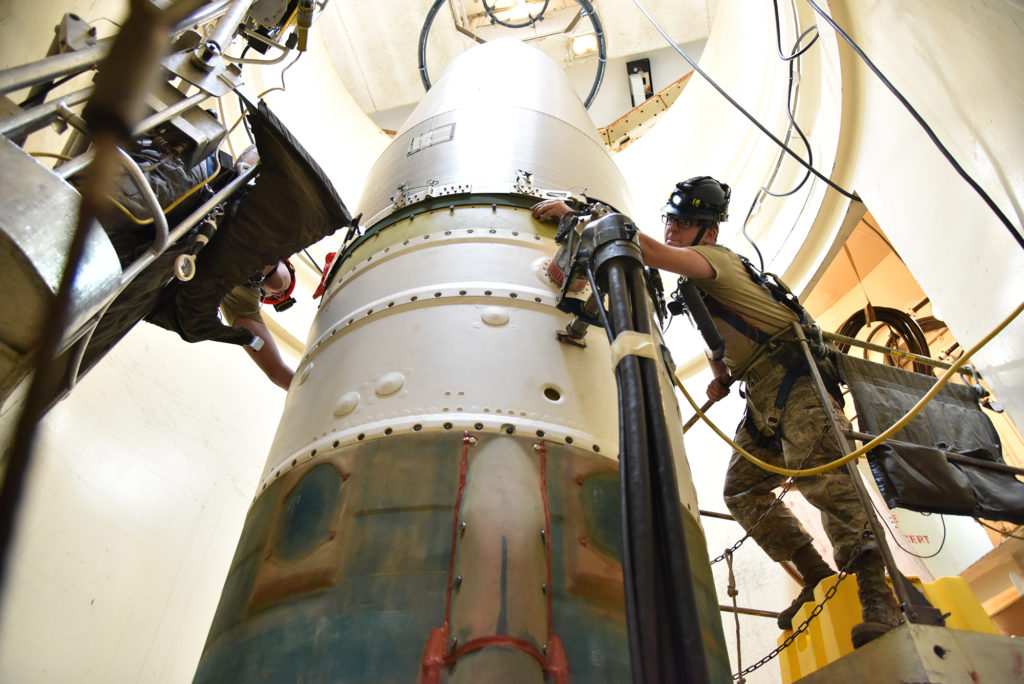The Air Force Safety Center unveiled a new strategic plan meant to help keep pace as the Air Force writ large expands its operations in space, updates its nuclear inventory, and aims to move faster in combat than it ever has before.
“As safety leaders, it’s our job to ensure the safety enterprise is trained, agile, and ready to integrate new Air Force operational concepts to deter, and if needed defeat, great power competitors,” Maj. Gen. Sean Choquette, the Air Force’s chief of safety and commander of the safety center, said in an April 2 release. “Safety’s job is to prepare our forces with the resources and skills to make risk-informed decisions at home or in combat.”
The DAF Safety Strategic Plan 2024-2027 lays out six goals meant to keep safety in the front of mind for Airmen and Guardians. One of them is to strengthen nuclear surety, which is the term for keeping nuclear weapons safe, secure, and reliable.
The Air Force has struggled with nuclear surety in the past: in 2007, the service mistakenly flew nuclear weapons on a B-52 from North Dakota to Louisiana and left the bomber unguarded for about nine hours. That incident helped lead to new training procedures, standards, and the creation of Air Force Global Strike Command to oversee nuclear surety.

Nearly 20 years later, the Air Force nuclear enterprise has major changes on the horizon as the service seeks to replace its aging Minuteman III intercontinental ballistic missile with the Sentinel ICBM. The Air Force also plans to buy at least 100 nuclear-capable B-21 bombers, and last month the F-35 fighter was certified to carry a nuclear bomb.
“Given the criticality of nuclear surety, the renewed focus on this capability, and the rapid growth of related programs, DAF Safety will continue ensuring the nuclear surety programs are correspondingly robust, comprehensive, and responsive to support this mission area,” the Center wrote.
The steps to get there involve developing a better nuclear surety operational assessment program; coordinating a plan to comply with new Defense Department standards, updating the Air Force’s nuclear surety policy, and upgrade the safety center’s mishap reporting system for “dull swords,” the term for nuclear events or deficiencies not categorized as an accident.
The Air Force Safety Center also seeks to integrate risk management into agile combat employment (ACE), the concept where small teams of Airmen launch and recover aircraft at remote or austere airfields, then relocate to avoid being targeted by enemy missiles. Many Airmen expect to carry out those operations without support and without connection to higher command, which is forcing a wider recalculation of risk across the service.
“We’re trying to teach our aeromedical evacuation members to assume risks that they probably would not have in the last 20 years when it comes to patient care,” one aeromedical evacuation Airman told Air & Space Forces Magazine in June.
“We are boiling down to old-school World War II tactics where we use rope, tape, and zip ties to pull submunitions off a runway all at once,” an Air Force Explosive Ordnance Technician added.
The Air Force Safety Center wants to update its framework for calculating risk in the age of ACE, which will start with a six-month evaluation of its risk management practices. The center aims to implement an initial version of an update plan within two years, followed by a full one within five.
But to be effective, whatever new plans are developed need to be practiced in the field.
“Ultimately, our safety mission success relies upon the disciplined approach of individual Airmen and Guardians—you are the vital component of the enterprise,” the center wrote.
To get after that, the first goal of the plan is to fully integrate risk management into all training and operations. The goal involves reviewing the “safety enterprise processes” for irrelevant tasks, launching a public affairs campaign on safety and risk management, and formalizing safety principles and risk management as Air Force core competencies.
Another Air Force Safety Center goals is to keep pace with the Space Force. Its objectives include developing a plan of action and milestones, determining the authorities for overseeing space safety within the Air Force and the wider Defense Department, and conducting a baseline manpower study in support of the space enterprise.
Beyond keeping pace with the new changes, the safety center wants to get ahead of the curve by using machine learning models to analyze safety data, providing better analysis to commanders through data visualization, and working with wing or delta safety offices to improve their processes.
“Mishap reporting data is a lagging indicator and limited tool,” the center wrote. “Our intent is to develop analytical tools to assist commanders with proactive risk reduction, mishap prevention, and maximized readiness.”
The Air Force Safety Center’s last goal is to modernize the safety workforce, largely by revamping formal safety education such as the Air Force Safety University. The center plans to take a look at the university’s infrastructure, budget, and course catalog.
Over the next few years, the safety center will set up offices of responsibility to oversee implementation of its strategic plan.
“Measuring success must be done by measuring results and outcomes,” the center wrote. “Success is not measured by checking off milestones passed or objectives completed.”